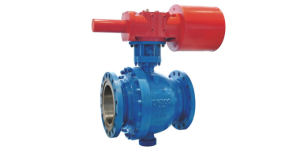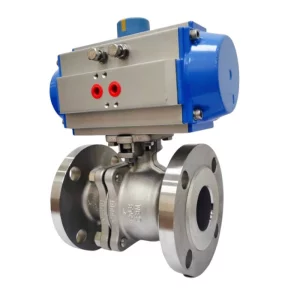What Are the Standard Sizes for Pneumatic Operated Ball Valves?
Overview of Pneumatic Operated Ball Valves
Definition and Functionality
Basic Definition
Pneumatic operated ball valves are the type of quarter-turn valve that is operated by a pneumatic actuator. They are used to regulate fluid flow and consist of a ball with a hole through its center that can be rotated to allow or stop flow, depending on its position.
Operational Mechanism
It works as follows: the pneumatic actuator, which is fixed to the valve, rotates the ball The actuator rotates the ball 90 degrees when air pressure is applied, thereby opening or closing the valve. It switches this mechanism, which is a swift and efficient way of flow control.
Importance in Industrial Applications
Industries Utilizing Pneumatic Operated Ball Valves
These valves are widely used across various industries, including oil and gas, chemical processing, water treatment, and power generation. Their ability to handle high pressure and temperature makes them ideal for demanding applications.
Advantages Of Manual Valves
Pneumatic operated ball valves are much faster to operate than manual valves and can often be controlled remotely with less manual intervention. They are also more reliable, which allows you to incorporate them into automated systems to improve organizational efficiency. They additionally provide greater uniformity and can be included right into automated systems for better performance.
Common Sizes for Pneumatic Operated Ball Valves
Size Range and Specifications
Typical Size Range
|
Size (Inches) |
Diameter (mm) |
|
1/2 |
15 |
|
3/4 |
20 |
|
1 |
25 |
|
1-1/2 |
40 |
|
2 |
50 |
|
3 |
80 |
|
4 |
100 |
|
6 |
150 |
Factors Influencing Size Selection
Sizing the valve is based on flow rate needs, pipe size compatibility, and system pressure. Bigger ones are usually selected for larger pour potentiality or large portions of medium. A higher flow rate or high-volume deduction of fluid will typically be a higher size.
Impact of Valve Size on Performance
Flow Capacity Considerations
Valve size directly affects flow capacity. Larger valves allow more fluid to pass through, making them suitable for applications requiring high flow rates. However, oversized valves may lead to inefficiencies in smaller systems.
Pressure Rating Implications
A valve size also impacts the pressure rating of the valve. A larger valve often has a higher pressure rating to resist more substantial forces within a system. To gain good performance, it is important to choose the valve according to the flow and pressure. The most important condition for the selection of the valve is to choose a valve with both flow and pressure that match the performance.
Materials Used in Pneumatic Operated Ball Valves
Commonly Used Materials
Stainless Steel Variants
Stainless steel is a popular choice due to its excellent corrosion resistance and durability. It is suitable for harsh environments where exposure to corrosive substances is common.
Brass and Bronze Options
Brass and bronze are used for their good mechanical properties and resistance to wear. They are often selected for applications involving water or non-corrosive fluids.
Material Selection Criteria
Corrosion Resistance Needs
Material selection should consider the fluid being handled. For corrosive environments, materials like stainless steel or specialized alloys are preferred to ensure longevity and prevent degradation.
Temperature and Pressure Requirements
The choice of materials is also influenced by the temperature and pressure of the system. For high-temperature applications, materials must not experience structural damage due to thermal stress, and for high-pressure systems, materials should have the ability to resist a very high external force without failure.
To sum up, knowing the standard sizes and material types for pneumatic-operated ball valves is essential to optimize their performance in industrial applications. These vital components used in fluid control systems work efficiently for a longer time if the proper selection is done based on size, material properties, and application requirements.
Installation and Maintenance Considerations
Installation Best Practices
Alignment and Positioning Tips
The optimum performance of pneumatic-operated ball valves is 100 dependent on the proper alignment and positioning. Align the valve and pipeline during the installation, do not exert stress on the valve components. Over time, misalignment causes leakage or damage. Also, think about how the actuator will be oriented so that maintenance and operation can be performed easily.
Ensuring Proper Sealing
Make certain that you install every gasket and that they are in fine shape so you can get a proper seal. This is particularly true at higher pressures or temperatures, where correct sealing materials must be used. If seals are inspected often during maintenance work it is possible to avoid leaks, which can result in increasing the working life of the valve.
Maintenance Protocols for Longevity
Routine Inspection Guidelines
Perform checks on general wear or corrosion on the valve body and actuator during routine inspections. Check to ensure that seals and gaskets are not deteriorating, which can cause performance issues. Lubricate moving parts if needed to keep it functioning, and keep tight any other connections.
Troubleshooting Common Issues
In the case of pneumatic-operated ball valves, air leaks in the actuator can be a major source of efficiency loss. Inspect air supply lines to make sure they are not leaking/blocked. If the valve cannot open or close properly, check the actuator for mechanical failures or a line of defective parts inside the valve. Fixing these issues sooner is better than later since it can turn into bigger problems in the future.
Exploring Miwival’s Offerings in Pneumatic Operated Ball Valves
Overview of Miwival’s Product Line
Key Features of Miwival Valves
Miwival provides pneumatic-operated ball valves of low wear and high accuracy. Significant attributes are strongly developed from strong resources, e.g., stainless steel, avoiding rusting as well as wear. Miwival valves are designed to control flow in a variety of applications with a very low-pressure drop.
Customization Options Available
Miwival provides customization options to meet specific application requirements. Customers can choose from various sizes, materials, and actuator types to tailor the valve to their system needs. This flexibility ensures optimal performance regardless of industry-specific demands.
Other Products by Miwival
Apart from pneumatic-operated ball valves, Miwival deals with a wide range of industrial valves such as globe control valves, eccentric rotary plug valves, gate valves, etc. Designed for reliable performance in the most demanding environments, each product is engineered to meet the most challenging applications in industries including oil & gas, chemical processing, and power generation.







